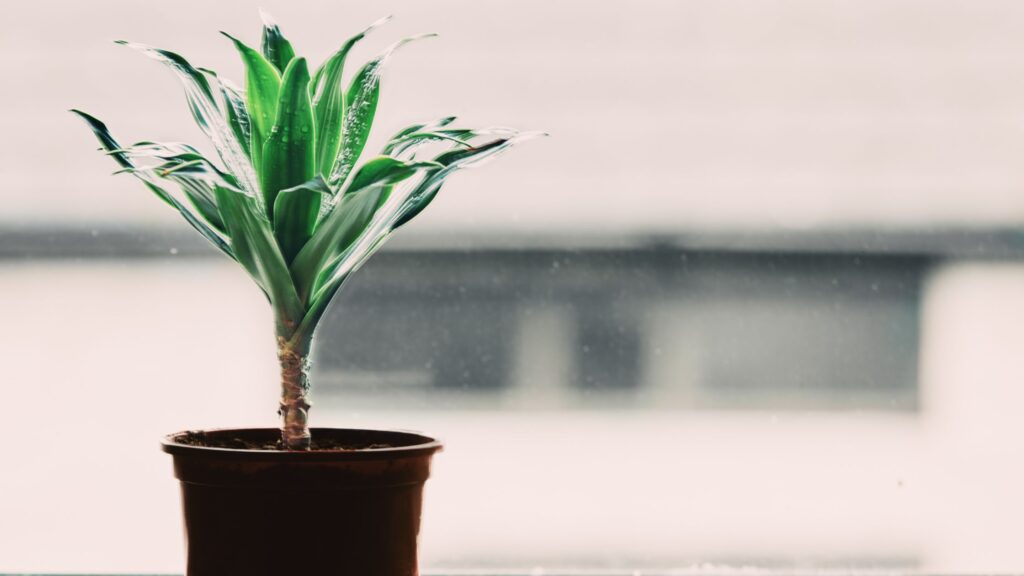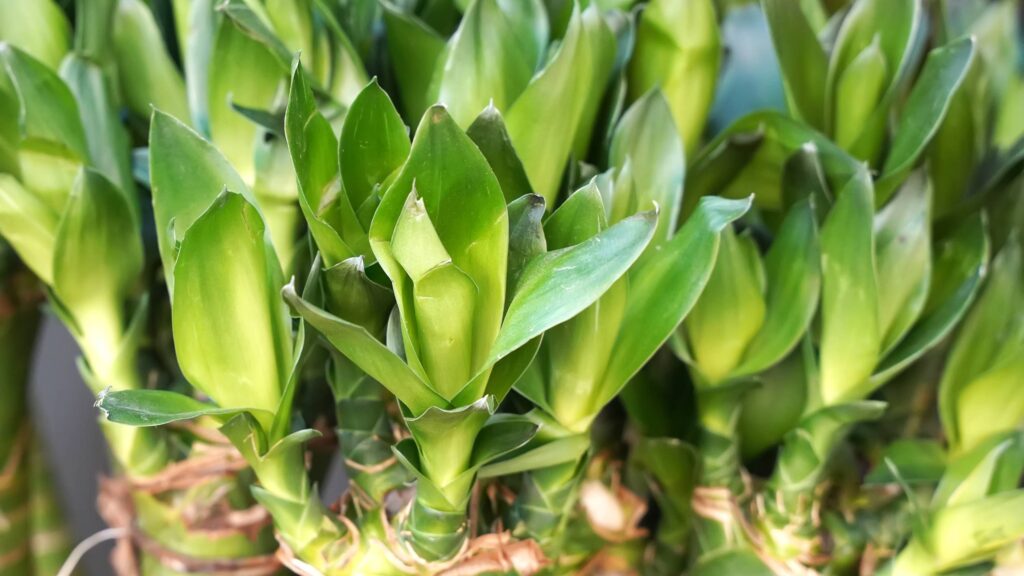Dracaena Sanderiana, commonly known as Lucky Bamboo, is a species of flowering plant in the family Asparagaceae, native to Central Africa. Despite its common name, it’s not a true bamboo but has a bamboo-like appearance. It was named after the German-English gardener Henry Frederick Conrad Sander

Types of Dracaena Sanderiana
Here are the two main ones:
Benefits of Dracaena Sanderiana
Here’s a breakdown of its advantages:
- Air Purification: While research on its specific effectiveness is ongoing, Dracaena Sanderiana is believed to help remove toxins like formaldehyde and benzene from indoor air which can improve overall indoor air quality.
- Low Maintenance: Lucky bamboo is known for being easy to care for. It thrives in indirect sunlight and requires minimal watering, making it a perfect choice for busy individuals or those new to plant parenthood.
- Aesthetics and Ambiance: Dracaena Sanderiana with its slender stalks and lush green foliage adds a touch of elegance and tranquility to any space. It comes in various arrangements and pot styles, allowing you to customize it to your décor.
- Symbol of Good Luck: In many cultures, particularly Feng Shui, Dracaena Sanderiana is considered a symbol of good luck, prosperity, and positive energy. It’s believed to bring harmony and fortune to your home or workspace.
- Improves Focus and Alertness: There are claims that Dracaena Sanderiana can enhance cognitive function, with studies suggesting it can improve focus and alertness.

Disadvantages of Dracaena sanderiana
One should be aware of the following possible drawbacks:
- Toxicity to Pets: Lucky Bamboo is toxic to pets, especially cats and dogs. If ingested, it can cause symptoms such as vomiting, drooling, and abdominal pain. Pet owners should keep Lucky Bamboo out of reach or choose non-toxic alternatives.
- Limited Flowering: Lucky Bamboo rarely flowers, especially when grown indoors. If you’re looking for a flowering plant, this may not be the best choice. When it does flower, the small white flowers are not particularly showy.
- Sensitive to Overwatering: Dracaena sanderiana can tolerate low-light conditions, but overwatering can be problematic. If it’s not placed near a window, be cautious with watering. It grows more slowly and uses less water, so it doesn’t dry out as quickly.
- Limited Air-Purifying Benefits: While Lucky Bamboo is often associated with air purification, scientific evidence specifically supporting its effectiveness is limited.
Dracaena Sanderiana Care
Here’s a humanized guide on how to care for it:
- Watering: Think of Lucky Bamboo as a friend who loves a good drink but doesn’t like to drown. Keep its “feet” (roots) in water, making sure it covers them by about an inch or so. Change the water every two weeks or so to keep it fresh, like giving your plant friend a clean glass to drink from.
- Light: Lucky Bamboo prefers bright, indirect light, similar to sitting by a window but not getting hit directly by the sun’s rays. Think of it as enjoying the gentle warmth of sunlight without getting sunburned.
- Temperature: Treat your Lucky Bamboo like you’d want to be treated—keep it away from extreme temperatures. It’s like shielding your friend from a hot summer day or a chilly winter night.
- Fertilizing: Lucky Bamboo doesn’t need much food, but a little boost now and then can make it happier. Use a diluted liquid fertilizer every couple of months during its growing season, like giving your friend a small treat to keep them healthy.
Propagation of Dracaena Sanderiana
Here’s a simple guide to propagating your Dracaena Sanderiana:
- Select a Healthy Parent Plant: Choose a healthy stem that has several segments of unblemished growth.
- Cutting: Using a clean, sharp knife or scissors, cut a stem section that includes at least one node (the raised rings on the stem where leaves grow). The cutting should be about 4-6 inches long.
- Drying: Allow the cutting to dry overnight to form a callus over the cut area. In soil or water, this helps keep things from rotting.
- Rooting Medium:
- Water: Submerge at least one node of the cutting in a jar of distilled water. For freshness, change the water once a week.
- Soil: If you prefer soil, plant the cutting in a pot with well-draining soil. Make sure the earth buryes the node.
- Indirect Sunlight: Position the container in a location with bright, indirect sunlight. The fragile young roots might be damaged by direct sunshine.
- Root Development: Roots should start appearing within a few weeks. Once the roots are a few inches long, you can transplant the cutting into a permanent pot if it is started in water.
- Care for New Plant: Treat the new plant as you would a mature Dracaena Sanderiana, following the usual care guidelines for light, water, and temperature.
Repotting of Dracaena Sanderiana
Please find attached a brief guide:
Select the Right Time: Spring or early summer is the ideal time to repot.
Choosing a New Pot Select a pot with adequate drainage that is marginally bigger than the one you now have.
Get the Soil Ready: Mix in some well-draining soil that can retain some moisture but let extra water run.
Thoroughly hydrate your plant before repotting it.
Take the Plant Out: Taking care not to injure the roots, gently remove the plant from its present pot.
To the New Pot Add Soil: Top the new container with a thin layer of dirt.
Orient the Plant: Plant the plant in the new container to the same depth as it was growing previously.
Fill with dirt: Gently firm down the earth around the plant.
Water Lightly: To aid with soil settlement, water the plant after repotting.
Dracaena Sanderiana Disease
Here are some common problems and their management:
Fluoride Toxicity or Alkaline Soil: Tan or brown coloring on the white areas of leaves and dead or yellow leaf tips may indicate fluoride toxicity or alkaline soil. To manage this, check your water and soil and make adjustments as needed.
Soft Rot Disease: Soft, brown spots on roots that smell rank may indicate soft rot disease. This is often caused by overwatering and poor drainage. Ensure good drainage in the pot and avoid overwatering to prevent this issue.
Leaf Spot Disease: Reddish or light brown spots surrounded by a yellow halo may mean your dracaena has leaf spot disease. For fusarium leaf spot, use a fungicide and improve watering practices to limit the infection.
Cold Damage: Yellow or dead bands across leaves can indicate your plant got too cold. Trim off the damaged parts and ensure the plant is kept in a warm, stable environment.
Pest Infestation: Visible pests, damaged leaves, or stunted growth may indicate an infestation of thrips, shore flies, scales, mealybugs, or fungus gnats. Consult with a local nursery for an appropriate pesticide and reduce watering to prevent pests
Dracaena Sanderiana Vastu
Here’s a simple guide:
- Direction: Place your Lucky Bamboo in the east or southeast direction. These directions are associated with growth, prosperity, and abundance.
- Number of Stalks: Choose the number of stalks based on your intentions. For example, three stalks symbolize happiness, longevity, and wealth, while five stalks represent overall prosperity.
- Care: Keep your Lucky Bamboo healthy by changing the water regularly and trimming any yellowing leaves. Healthy plants contribute to positive energy flow.
- Placement: Put your Lucky Bamboo in a prominent location, like the living room or office reception area, to attract positive vibes. Avoid placing it in bedrooms or bathrooms.
Dracaena Sanderiana for Pets
Unfortunately, Dracaena Sanderiana, despite the appealing name “lucky bamboo,” is not a good choice for a pet-friendly household. Here’s why:
- Toxicity: The culprit is a compound called saponin found in the leaves and stems of Dracaena Sanderiana. This substance can cause irritation and discomfort to pets if ingested.
How to Buy Dracaena Sanderiana
Here are a few pieces of buying advices:
Online Retailers: Many online retailers sell Dracaena Sanderiana. You can find them on gardening-specific sites or general e-commerce platforms.
Specialty Stores: For more unusual varieties, you might want to check out specialty houseplant suppliers or buy online.
Dracaena Sanderiana Names in Other Languages
here are the names for Dracaena sanderiana (Lucky Bamboo) in other languages:
- Chinese: 幸运竹 (Xìngyùn zhú)
- Japanese: 幸運竹 (Kōun take)
- Korean: 행운대자 (Haeng-un daeja)
- Hindi: भाग्यशाली बांस (Bhagyashali baans)
- Spanish: Bambú de la suerte
- French: Bambou porte-bonheur
- German: Glücksbambus
- Italian: Bambù della fortuna
- Portuguese: Bambu da sorte
- Russian: Бамбук счастья (Bambuk schast’ya)
Conclusion
Dracaena sanderiana, commonly known as Lucky Bamboo, is a popular houseplant that’s often associated with good fortune and luck in Feng Shui practices.
FAQs of Dracaena Sanderiana
- What are the types of Dracaena Sanderiana?
Ans: Dracaena Sanderiana is commonly known as Lucky Bamboo, and it comes in various forms such as straight stalks, twisted stalks, and curly stalks. - What are the benefits of having a Dracaena Sanderiana (Lucky Bamboo)?
Ans: Dracaena Sanderiana, or Lucky Bamboo, is believed to bring good luck, prosperity, and positive energy into a home. It’s also easy to care for and adds a touch of greenery to indoor spaces. - Are there any disadvantages to having a Dracaena Sanderiana (Lucky Bamboo)?
Ans: While Dracaena Sanderiana is generally safe, it can be toxic to pets if ingested. It’s important to keep it out of reach of curious pets. - How do you take care of Dracaena Sanderiana (Lucky Bamboo)?
Ans: Dracaena Sanderiana thrives in indirect sunlight and can be grown in water or soil. Change the water regularly and keep the roots submerged. If grown in soil, keep the soil consistently moist but not waterlogged. - How do you make more Dracaena Sanderiana (Lucky Bamboo)?
Ans: Dracaena Sanderiana can be propagated by taking stem cuttings and placing them in water until roots develop. Then, they can be planted in soil or kept in water. - When should you repot Dracaena Sanderiana (Lucky Bamboo)?
Ans: Repotting is usually done when the plant outgrows its current container or if the roots become crowded. Use fresh soil and a slightly larger pot to accommodate growth. - What can make Dracaena Sanderiana (Lucky Bamboo) sick?
Ans: Overwatering or waterlogged roots can lead to root rot in Dracaena Sanderiana. Ensure proper drainage and water sparingly to prevent this issue. - Is there anything special about where you put Dracaena Sanderiana (Lucky Bamboo)?
Ans: Some people believe that placing Dracaena Sanderiana in certain areas of the home can bring luck, prosperity, and positive energy. - Is Dracaena Sanderiana (Lucky Bamboo) safe for pets?
Ans: Dracaena Sanderiana can be toxic to pets if ingested. Pets should ideally not be able to reach it. - How do you buy Dracaena Sanderiana (Lucky Bamboo)?
Ans: When buying Dracaena Sanderiana, look for healthy, vibrant stems with no signs of damage or rot. Ensure that the roots are intact and that the plant is well-hydrated if purchasing in water.






Magnificent goods from you, man. I have be aware your stuff prior to and you’re simply extremely excellent. I actually like what you’ve acquired here, certainly like what you are stating and the best way by which you assert it. You’re making it entertaining and you still care for to stay it sensible. I cant wait to learn much more from you. That is actually a terrific website.